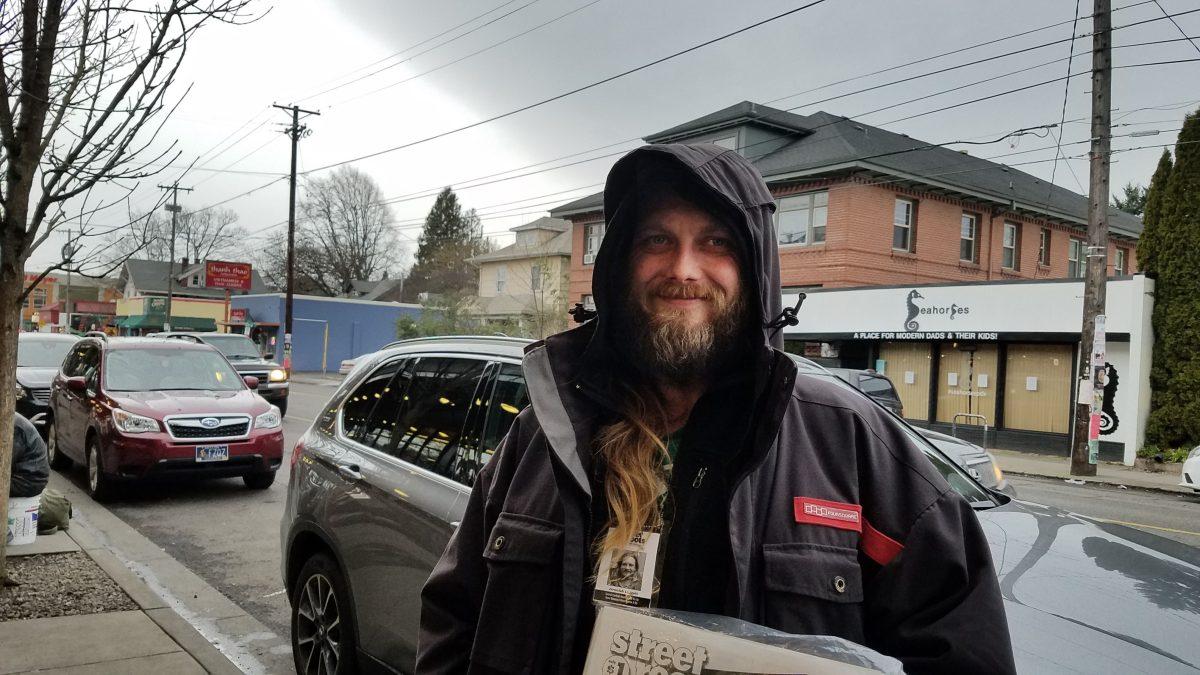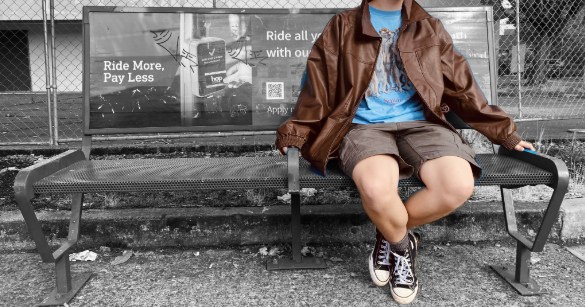
When Jeremiah returned to Portland in 2003, he was 22 years old and had been shooting drugs for five years. Statistically, he should have been dead. He entered a rehab program, but for the first 90 days he wasn’t allowed to have a job, and he needed coffee. “When you’re getting off drugs, coffee is really good, and that’s not free,” says Jeremiah.
“So I had to make money somehow, and one of the people in treatment suggested… Street Roots.” Jeremiah worked as a vendor, buying copies for 25 cents and selling them for a dollar. Jeremiah has been on-and-off homeless for the past 14 years.
Many independent organizations in Portland and elsewhere are fighting to alleviate homelessness. Street Roots, a weekly newspaper that focuses on social justice issues in the Portland area, is one of the most celebrated. Copies are distributed by homeless Portlanders, who volunteer as vendors. There are currently about 170 volunteers. “Vendors are in a sense ambassadors, and so many vendors take this really seriously, really caring about treating people well, reflecting well on other vendors, reflecting well on other people who are suffering homelessness or poverty,” says Street Roots Director Kaia Sand. Jeremiah, who has been a vendor for 14 years reflects, “Street Roots literally helped get me through treatment and literally saved my life.”
After graduating from his treatment program, Jeremiah was able to pay rent with his Street Roots revenue, splitting the cost with a roommate. For him, it was about $300 a month. However, housing prices have since increased. “I make about the same amount of money as I did back [in 2004]… Things were affordable. Back then a MAX ticket was 75 cents.” Changes in the housing market have led West Coast states to experience a housing crisis, and an accompanying growth in the homeless population.
In October 2017, Multnomah County published a Point-in-Time report, meant to provide a “snapshot” of people experiencing homelessness on the night of Wednesday, February 22, 2017, in the Portland Metro Area. The report found that on that night, 4,177 people in the region were homeless. This number had increased by 9.9 percent over the past two years. The study acknowledged that due to the difficult nature of conducting such a census, the actual number of people experiencing homelessness was likely much higher. However, even at this level, the data is worrying. Portland, like many other cities on the West Coast, has been experiencing a housing crisis. Numerous steps are currently being taken at a state, city, and community level both to help the already homeless, and to prevent homelessness from occurring altogether.
Many factors contribute to Portland’s high rate of homelessness. 60.5 percent of those surveyed in the 2017 study reported that they were living with a mental or physical disability. Issues in Oregon’s health care system are likely a contributing factor. The study also indicated that at least two thirds of those surveyed were not from Multnomah County. Due to the relative abundance of transitional housing facilities and shelters in Portland, many homeless people from across the country have migrated to Multnomah County. However, the most direct cause of homelessness is simply inability to pay rent.
Oregon is the third worst state in the nation when it comes to home ownership. Housing prices and gentrification have increased dramatically in recent years, making the Portland Metro Area less economically diverse. Oregon is about 155,000 housing units short. “People want to move here,” says Tawna Sanchez, the Oregon state House Representative for North and Northeast Portland. “We don’t have sales tax, you don’t have to pump your own gas—there [are] a lot of perks to Oregon.”
“Things were affordable. Back then, a MAX ticket was 75 cents.”
–Jeremiah, Street Roots Vendor
“The economic gains we’ve seen have not been spread fairly,” explains Joint Office of Homeless Services Communications Coordinator Denis Theriault. Previously, average rent could be paid with a minimum wage salary. This is no longer the case.
“Portland didn’t used to be like this… In the 90s when I got here, if you wanted to have shelter, there was shelter here. If you wanted a job, there was a job,” reflects Jeremiah.
“Access to home ownership and a livable wage has been a struggle for a lot of people, but it’s in particular been a struggle for people of color,” says Sanchez. People of color are disproportionately affected by homelessness throughout Oregon.
“If you’re African American in this city, if you’re Native American in this city, the average household income is half that of a white-led household,” Sand elaborates. “African American, Native American households on average cannot afford any rent in our city.”
State House Representative Alissa Keny-Guyer is working on two bills for this legislative session that would deal with this issue. The first, if passed, would create a task force to address racial disparity in home ownership throughout Oregon. The second would streamline the process of adjusting home ownership titles to remove racially discriminatory language. “Some titles say ‘colored people may not live here unless they’re domestic…’ So we’re trying to help people remove that,” Keny-Guyer explains.
A lack of sufficient medical services also contributes to homelessness. “Some people desperately do need medication,” explains Jeremiah. “They need a doctor. They need to have an advocate. They literally need somebody to hold their hand and make sure they take their medicine. When you cut funding for that and you kick those people to the street, they’re obviously not gonna take their medicine because they can’t take care of themselves. You wouldn’t kick a three year old to the street and say ‘figure it out,’ [but] that’s about what they’ve done.”
Theriault agrees, stating, “The federal government has really failed us for 30 years.” He explains that lacking federal Medicaid funding has placed another burden on city budgets, taking money away from homelessness relief efforts.
Students are also affected by homelessness. Between the 2005 and 2015 school years, the number of homeless students throughout the state increased from about 13,000 to well over 21,000. About 10 percent of students in Oregon are homeless. That number varies by school district, from Harney County and Burnt River, with no homeless residents, to Butte Falls, where nearly 30% of students are experiencing homelessness.
One major program is Emergency Housing Assistance (EHA). Through EHA, funds are distributed to rent-burdened or severely rent-burdened people to help pay rent and utilities, such as electricity and phone bills. This system gained prominence in February 2017, when an apartment building housing 26 students of Rigler Elementary School doubled its rent under new ownership. EHA money was directed to pay the extra amount long enough for each student to finish out the school year before moving. “[EHA] often just buys time for people to… find something new. Or if they’re already homeless, it might be helping people with relocation expenses,” says Keny-Guyer. About two thirds of Oregon’s general fund money dedicated to homelessness is allocated to EHA.
Much of the remaining fund money is directed to Oregon’s State Homeless Assistance Program (SHAP). The program also receives funds from cities and counties and is tasked with meeting the immediate needs of the homeless. This includes building and running homeless shelters. Thanks to SHAP money, three new city shelters have recently been opened in Portland, together providing 600 new beds.
Shelters have proven effective. Over the past year, while the number of homeless people in Portland has increased, the number of unsheltered homeless people has gone down. Despite this, these shelters—particularly one on SE Foster Rd—have sparked controversy. Local residents complain that the shelter, which will house as many as 130 homeless people, is too close to a school, and to their homes. However, homelessness in the area is undeniably a problem. In fact, Portlanders have expressed contradicting views regarding homelessness. In an October 2017 representative poll of 300 Portlanders, the majority, while reporting feelings of sympathy and concern toward the homeless, did not describe having personally dedicated any of their time or money towards the issue.
Many city workers have a tense relationship with the homeless, in particular members of the Portland Police Bureau. “There needs to be a higher accountability for police and public servants and how they deal with the homeless, and especially deal with the mentally ill,” says Jeremiah. In 2011, the federal government announced an investigation into how Portland’s police force treats the mentally ill. The investigation was prompted by a number of instances in which police improperly used deadly force against the mentally ill, such as in the cases of James Chasse and Raymond Gwerder. A settlement between the city and federal government followed, mandating police reform.
“When I first got to Portland in ‘95, I had dropped out of the ninth grade, and I was able to get a job—my first interview,” says Jeremiah. “And that boss paid me to take time off so I could get my GED. That’s the quality of people here in Oregon. That’s why I came back to Oregon in 2003… That’s kind of what makes Portland strong, is the fact that we talk to each other and we stand up for one another. It’s one of the things that’s kept me around here.”
Despite his optimism, Jeremiah recognizes that Portland has a long ways to go. “It’s starting to get better, and there are a lot of community groups that do a lot, and there’s a lot of good people to help, but there’s not enough to meet the need as it stands, and Portland has a long way to go to meet that need,” he says. “I see it every day I’m out here.”


































